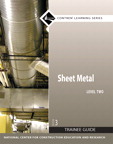Many in the sheet metal works industry are not eager to talk about safety until something goes wrong. Obviously, by then it’s too late.
The setup, operation and maintenance of roll-forming equipment for ductwork fabrication requires a keen safety awareness for anyone working in the same facility.
Canada-based Samco Machinery manufactures roll-forming equipment, much of it custom made, for a variety of industries: transportation, energy, storage, consumer products and HVAC construction.
Samco Machinery completed a move into a new 164,000-square-foot plant in Toronto during 2013. Setting up a plant to accommodate product flow is important, but it’s just as important to do it with safety in mind. The legal requirements for producing safe equipment in Ontario are strict, stricter than the requirements of many places customers will be running the equipment. This expertise goes a long way to helping customers in their own plants, company officials say.
“We set up the plant to best suit product flow,” said Gerry Birmingham, vice president of engineering at Samco Machinery. “Then we assessed hazard potential.”
The company explained some of the ways its plant was laid out to enhance safety.
For instance, in shipping bays, guard rails were installed to keep pedestrians safe and lines were painted on the floor to indicate safe walkway areas and restricted areas.
“Those markings are great for your employees and are helpful to plant visitors as well,” Birmingham said. “You’ll have customers or other visitors in the plant who are often distracted by their surroundings during a walking tour, not paying as close attention to what’s in front of them. You want to keep these walkways away from potentially dangerous areas like transition areas, pits and rail tracks.”
Tangled up
Consider where the installation of electrical equipment and cords are going to be located so they do not create tripping hazards. Birmingham suggests installing transformers “up and out of the way.”
Fire extinguisher, eyewash and first-aid stations should not be afterthoughts during the design and layout process. These areas should be highly visible and accessible in work areas.
“Believe it or not, lighting plays a part in safety,” Birmingham said. “In the new plant, we’ve upgraded to high efficiency lighting so there is plenty of light in work areas, no dark spots in areas where someone is working.”
As anyone in HVAC construction knows, air quality is an important consideration to the short- and long-term health of employees. The new Samco plant has an exhaust system that also removes hot air during the summer months. To protect the hearing of people in the plant, noise-generating machines are situated strategically so noise will be directed toward a wall or away from employees.
“We also made sure there are clear paths for evacuation in the occurrence of a catastrophic event,” Birmingham said. “You hope it never happens, but you have to be prepared for anything.”
In the Samco Machinery plant, main aisles shared by pedestrians and forklifts are wide enough so pedestrians can safely pass.
Company officials recommend every shop look at its layout and aisles.
“Floor space is very expensive when building a plant, so space must also be used efficiently, with safety in mind,” Birmingham said.
Staging
Ensure there are adequate staging areas for material waiting to be transferred to another process within the shop. They are not always being used to capacity, but these areas are important, with the goal of keeping material out of the way. Birmingham said it’s important to adjust efficiencies to best safety practices.
“Samco visits a lot of customer plants,” Birmingham said. “We’re manufacturing and installing equipment so we are occasionally introduced to some innovative ideas they’re employing at their plants.”
One customer performed a return-on-investment analysis on situating all of its heat exchangers in a central area to best use the heat being produced for summer and winter.
“The initial cost was high, but the return easily justified the investment,” he said. “Between what we learn from our customers and what we learned in our two previous plants, we have created an even safer and more efficient working environment.”
Now in a larger plant featuring larger and longer lines, with fewer operators required to run equipment, taking advantage of modern communication devices has increased efficiency and safety. Operators no longer have to walk from one end of the line to the other or from one end of the plant to the other.
“Even though these lines are growing, they may only require one or two operators,” Birmingham said. “Ultimately, they’re responsible for knowing what’s going on all the way down the line. Safety is very much a part of the planning process when installing any machine or line.”











